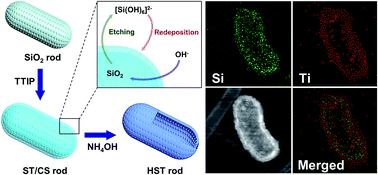Fabrication of a silica/titania hollow nanorod and its electroresponsive activity†
Abstract
In this study, a 1D oriented hollow SiO2/TiO2 (HST) rod-like material was successfully fabricated via a sequential combination of sol–gel use, TiO2 incorporation, and a sonication-mediated etching and redeposition method. This carefully manipulated new material has numerous advantageous physical and intrinsic properties, such as increased surface area, pore volume, interfacial polarization, and dielectric properties introduced from each synthetic step. The synthesized HST rod was adopted as an electrorheological (ER) material for practical examination of these characteristics. The HST rod materials exhibited 1.5- and 3-fold higher ER performance than a non-metal SiO2 rod and a non-hollow SiO2/TiO2 core/shell (ST/CS) rod, which are interim synthetic steps. Moreover, the HST rod exhibited remarkable 6-fold increased ER efficiency relative to a sphere-shaped hollow SiO2/TiO2 particle synthesized using a similar experimental method. These notable enhancements in ER performance are attributed to incorporation of the experimentally designed characteristics of the HST rod: 1D structure, metal oxide incorporation, and creation of a hollow cavity. For future study, we expect that these versatile HST rod materials can be applied in a range of fields including drug delivery, photo-catalysis, and as building blocks.



 Please wait while we load your content...
Please wait while we load your content...